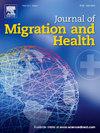黎巴嫩境内受流离失所影响的儿童和青少年确定的与健康和福祉需求有关的社会联系:一项参与性研究
IF 2.9
Q1 PUBLIC, ENVIRONMENTAL & OCCUPATIONAL HEALTH
引用次数: 0
摘要
儿童和青少年周围的社会关系支持他们面对挑战和寻求帮助,最终在他们的整个生命过程中成为心理、身体和行为健康结果的保护因素。在政治不稳定和混乱的复杂背景下,这些社会资源往往断裂、紧张或完全无法获得,这限制了这些人口获得基本服务的机会,并影响了这些人口的结果。本研究旨在通过试点测试社会联系绘图参与性评估工具,确定、描述和直观地描绘与黎巴嫩受流离失所影响的儿童和青少年的健康和福祉需求相关的社会联系。我们假设这种独特的方法将快速有效地识别和描述不同群体的社会关系。方法对科学文献和灰色文献进行初步范围审查,然后与利益相关者面谈,确定了指导PATMSC(一种识别和可视化社会关系类型和质量的混合方法数据收集工具)主题的营养、心理健康和虐待情景。该方案在黎巴嫩受流离失所影响的儿童、照料者和提供者中试行。结果整个PATMSC研讨会共有7组(叙利亚儿童、叙利亚青少年、叙利亚照顾者、黎巴嫩/巴勒斯坦儿童、黎巴嫩/巴勒斯坦青少年、黎巴嫩/巴勒斯坦照顾者和提供者)42名参与者。叙利亚儿童在所有场景中识别的连接最多(66个节点),黎巴嫩/巴勒斯坦青少年在所有场景中识别的连接最少(26个节点)。家庭和社区节点在所有场景中都高度连接。56%的参与者向家人寻求帮助。家庭关系在儿童(71%)和提供者(33%)亚组中使用最多。受访者寻求家庭关系帮助的比例最高(59%)。在分组中,儿童(84%)、黎巴嫩/巴勒斯坦参与者(73%)、提供者(50%)和照顾者(36%)也最常通过家庭关系寻求帮助。该研究强调,在黎巴嫩流离失所的儿童、青少年和他们的照顾者在探索与关注的关键领域相关的资源时,具有不同的社会联系。总的来说,家庭成员在他们的社交网络中的作用是很重要的。然而,社会关系和可用资源因环境而异,这可以从三种情况下的关系变化中得到证明。了解社会网络的组成部分,驱动它们的因素,以及它们在不同部门之间的差异,对于规划和维护满足资源受限环境中不断变化的需求的项目和政策至关重要。本文章由计算机程序翻译,如有差异,请以英文原文为准。
Social connections related to health and well-being needs identified by children and adolescents affected by displacement in Lebanon: a participatory research study
Introduction
The social connections surrounding children and adolescents support them in facing challenges and seeking help, ultimately acting as a protective factor in their mental, physical, and behavioral health outcomes across the life course. In complex contexts of political instability and dislocation, these social resources are often fractured, strained, or altogether unavailable, which restricts access to essential services and affects outcomes for these populations. This study aims to identify, characterize, and visually depict social connections related to the health and well-being needs of children and adolescents affected by displacement in Lebanon, by pilot testing the Participatory Assessment Tool for Mapping Social Connections (PATMSC). We hypothesize that this unique methodology will identify and describe different social connections by group quickly and efficiently.
Methods
An initial scoping review of scientific and grey literature followed by stakeholder interviews identified nutrition, mental health, and abuse scenarios that guided the PATMSC (a mixed- method data collection tool that identifies and visualizes types and qualities of social connections) topics. The PATMSC was piloted among children, caregivers, and providers affected by displacement in Lebanon.
Results
There were seven groups (Syrian children, Syrian adolescents, Syrian caregivers, Lebanese/Palestinian children, Lebanese/Palestinian adolescents, Lebanese/Palestinian caregivers, and providers) with a total of 42 participants across the PATMSC workshops. Syrian children identified the most connections across all scenarios (66 nodes) and Lebanese/Palestinian adolescents identified the fewest connections across all scenarios (26 nodes). Family and community nodes were highly connected across all scenarios. 56% of participants asked their family connections for help. Family connections were the most used by children (71%) and provider (33%) subgroups. Participants were asked for help by family connections the most (59%). Within subgroups, children (84%), Lebanese/Palestinian participants (73%), providers (50%), and caregivers (36%) were also asked for help by family connections the most.
Discussion
The study highlights that children, adolescents, and their caregivers in displaced settings in Lebanon have varied social connections when exploring resources related to key areas of concern. Overall, there is an importance placed on the role of family members in their social networks. However, the social connections and resources available differ depending on the circumstances, as evidenced by the variation in connections named across the three scenarios. Understanding the components of social networks, what drives them, and how they differ by sector, is essential in planning and maintaining programs and policies that meet evolving needs in resource-constrained settings.
求助全文
通过发布文献求助,成功后即可免费获取论文全文。
去求助
来源期刊

Journal of Migration and Health
Social Sciences-Sociology and Political Science
CiteScore
5.70
自引率
8.70%
发文量
65
审稿时长
153 days
 求助内容:
求助内容: 应助结果提醒方式:
应助结果提醒方式:


